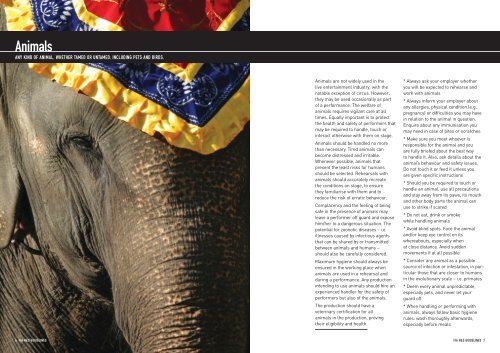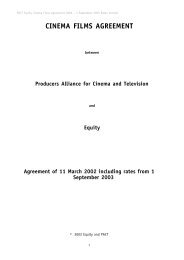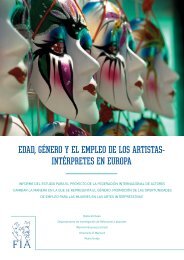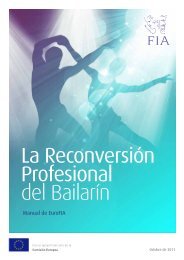ACTSAFE
landscape version - the International Federation of Actors
landscape version - the International Federation of Actors
- No tags were found...
Create successful ePaper yourself
Turn your PDF publications into a flip-book with our unique Google optimized e-Paper software.
Animals<br />
ANY KIND OF ANIMAL, WHETHER TAMED OR UNTAMED, INCLUDING PETS AND BIRDS.<br />
Animals are not widely used in the<br />
live entertainment industry, with the<br />
notable exception of circus. However,<br />
they may be used occasionally as part<br />
of a performance. The welfare of<br />
animals requires vigilant care at all<br />
times. Equally important is to protect<br />
the health and safety of performers that<br />
may be required to handle, touch or<br />
interact otherwise with them on stage.<br />
Animals should be handled no more<br />
than necessary. Tired animals can<br />
become distressed and irritable.<br />
Whenever possible, animals that<br />
present the least risks for humans<br />
should be selected. Rehearsals with<br />
animals should accurately recreate<br />
the conditions on stage, to ensure<br />
they familiarise with them and to<br />
reduce the risk of erratic behaviour.<br />
Complacency and the feeling of being<br />
safe in the presence of animals may<br />
leave a performer off guard and expose<br />
him/her to a dangerous situation. The<br />
potential for zoonotic diseases - i.e.<br />
illnesses caused by infectious agents<br />
that can be shared by or transmitted<br />
between animals and humans –<br />
should also be carefully considered.<br />
Maximum hygiene should always be<br />
ensured in the working place when<br />
animals are used in a rehearsal and<br />
during a performance. Any production<br />
intending to use animals should hire an<br />
experienced handler for the safety of<br />
performers but also of the animals.<br />
The production should have a<br />
veterinary certification for all<br />
animals in the production, proving<br />
their eligibility and health.<br />
* Always ask your employer whether<br />
you will be expected to rehearse and<br />
work with animals<br />
* Always inform your employer about<br />
any allergies, physical condition (e.g.<br />
pregnancy) or difficulties you may have<br />
in relation to the animal in question.<br />
Enquire about any immunisation you<br />
may need in case of bites or scratches<br />
* Make sure you meet whoever is<br />
responsible for the animal and you<br />
are fully briefed about the best way<br />
to handle it. Also, ask details about the<br />
animal’s behaviour and safety issues.<br />
Do not touch it or feed it unless you<br />
are given specific instructions<br />
* Should you be required to touch or<br />
handle an animal, use all precautions<br />
and stay away from its paws, its mouth<br />
and other body parts the animal can<br />
use to strike if scared<br />
* Do not eat, drink or smoke<br />
while handling animals<br />
* Avoid blind spots. Face the animal<br />
and/or keep eye control on its<br />
whereabouts, especially when<br />
at close distance. Avoid sudden<br />
movements if at all possible<br />
* Consider any animal as a possible<br />
source of infection or infestation, in particular<br />
those that are closer to humans<br />
in the evolutionary scale – i.e. primates<br />
* Deem every animal unpredictable,<br />
especially pets, and never let your<br />
guard off<br />
* When handling or performing with<br />
animals, always follow basic hygiene<br />
rules: wash thoroughly afterwards,<br />
especially before meals<br />
6 FIA H&S GUIDELINES<br />
FIA H&S GUIDELINES 7







